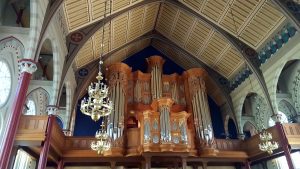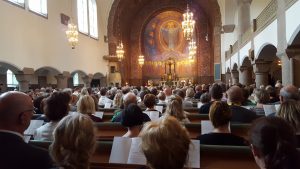What did we learn, and what’s next?
One Thursday in mid-March, the atmosphere in the Music Office was unusually tense. Greenwich Public Schools had just announced that they would suspend in-person teaching for the foreseeable future. Should we follow suit? After all, we had been working hard towards Choral Evensong the following Sunday, one of a series to prepare for our upcoming choir tour to England. On a practical level, our usual Thursday evening choir dinner was all prepared. Surely we couldn’t cancel at such short notice?
I am very much of the ‘keep calm and carry on’ school, so my first instinct was to do just that. However, since our policy is generally to follow the public schools in terms of snow days and closings, we reluctantly decided that we should suspend in-person rehearsals. Of course, this was absolutely the right decision, but the fact that we deliberated over it shows how little we knew about this virus during the waning days of winter.
We were now left with an entirely blank canvas. How on earth were we to keep momentum going for the 60 young people who sing in our choirs, at the same time as constructing a new paradigm for worship? What about the Christ Church Singers? These dedicated adults are a community in themselves, one that would require nurturing through the crisis. And then there were all the professional singers to care for, many of whom rely on the income they receive from the church. This was a major conundrum that would take some sorting out.
In a testament to the strength of the staff team at Christ Church, it was not long before a new structure emerged. Volunteers worked hard with an outside company to install a camera, so that we could live-stream in time for Palm Sunday. Meanwhile, we finally figured out how to position a quartet of singers in the chancel while still socially distancing. A mid-week Choral Evensong attracted viewers from across the globe. Our musical plans for Holy Week were scrapped; instead, we completely redesigned the shape of our liturgies and their musical components. Our clergy, musicians, and administrators pulled together in remarkable ways to keep our ‘sacrifice of praise’ on track through the busiest (and, it seemed, the coldest) week of the Christian year.
Behind the scenes, choir rehearsals with our choristers switched to Zoom. This was a steep learning curve for me in particular. I remember one rehearsal with the boys that descended into near anarchy as most were switching their screen names and backgrounds, while sharing their screens across the platform. However, towards the end of the rehearsal, one of the main instigators helpfully showed me how to switch off various enabling capabilities, resulting in a much more orderly setting the next time we met. Interestingly, attendance at these rehearsals increased during the pandemic, perhaps as a result of there being no sport to compete with.
Teen ‘check-ins’ complemented our girl and boy rehearsals. Our youth ministers were present at these, to great effect. Some of our professional men joined our voice teacher in providing rigorous musical theory and voice instruction for small groups. Not to be outdone, the Christ Church Singers held a number of online social events, maintaining the ‘esprit de corps’ for which they are renowned.
All these services and rehearsals were topped off every Friday by an organ recital given by Associate Director of Music Jonathan Vaughn, live streamed from the chapel on the newly installed Visser Rowland organ. These recitals attracted a loyal audience, who enjoyed both the music and the friendly banter between audience members in the chat side-bar.
On the first Sunday of lockdown, I made a video for the choirs in which I said “maybe God is teaching us lessons that we didn’t know we needed to learn”. I believe that to be true. The first lesson is that a choir is so much more than a group of individuals; it is a community that needs to be in community in order to thrive and grow. Leaders and choristers sense that intuitively, which made weaving the threads into a new fabric easier than it might have been.
The second lesson for me is that, while planning is good, we need to remain nimble enough to respond to unexpected external circumstances. Perhaps I had grown too comfortable with my giant whiteboard, with its plans for this year and as far ahead as 2024!
Thirdly, the lockdown has forced us to acknowledge the power and potential of technology. This has implications for how we see ourselves as a church. I know parishioners who moved away geographically, but who ‘returned’ to Christ Church during the pandemic due to their own smaller churches being shuttered. How do we capitalize on this for the good of the wider church? Perhaps it is time to reconsider the ancient notion of ‘minster’ churches whose reach is broader than their immediate locality. This effect need not be confined to national borders either, since several of our live-stream attendees joined us from overseas.
Looking ahead, Christ Church Music is trying to learn from the lessons of the pandemic in order to produce authentic worship adorned by the most beautiful music possible. In the short-term this will inevitably involve smaller groups of musicians at rehearsals and services, and a schedule that takes into account the need to physically separate congregations. One upside to this is that we plan to hold weekly Choral Evensong in the church during the fall, in order to allow our choristers a performance routine that will enable them to continue to develop the skills for which our music program is so well known.
Finally, Christmas is likely to look a little different this year, likely being more akin to the traditional Christmases of Thomas Hardy rather than King’s College, Cambridge. But that’s OK. Maybe that can teach us something too. For the riches of our tradition are deep and enduring, and we are its current custodians. When we do finally return to packed churches with full choir stalls, I am confident that it will be all the stronger for having been on this journey.
Jamie Hitel
Director of Music, Christ Church Greenwich, CT


 Peter Rollins would argue that, like the Samaritan woman, such an encounter is only possible in the desert. For, ‘it is in this desert, as we wander together as nomads, that God is to be found. For it is here that we are nourished by our hunger.’
Peter Rollins would argue that, like the Samaritan woman, such an encounter is only possible in the desert. For, ‘it is in this desert, as we wander together as nomads, that God is to be found. For it is here that we are nourished by our hunger.’

